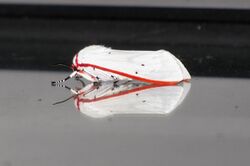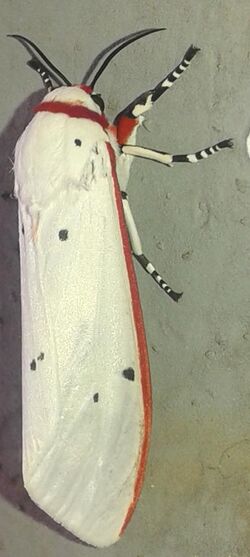Biology:Aloa lactinea
| Red costate tiger moth | |
|---|---|

| |
| Side view | |

| |
| Top view | |
| Scientific classification | |
| Domain: | Eukaryota |
| Kingdom: | Animalia |
| Phylum: | Arthropoda |
| Class: | Insecta |
| Order: | Lepidoptera |
| Superfamily: | Noctuoidea |
| Family: | Erebidae |
| Subfamily: | Arctiinae |
| Genus: | Aloa |
| Species: | A. lactinea
|
| Binomial name | |
| Aloa lactinea (Cramer, 1777)[1]
| |
| Synonyms | |
| |
Aloa lactinea, the red costate tiger moth, is a moth of family Erebidae. The species was first described by Pieter Cramer in 1777. It is found in India , Japan , southern and western China ,[2] Taiwan, Java, Sumatra, Sri Lanka, Myanmar[1] and the Philippines .
Description
Its wingspan is about 40 mm long.[3] The abdomen is yellow. Antennae black with a scarlet basal joint. Palpi scarlet at sides, white below, the terminal joint black. Head white with a crimson line behind it. Thorax white. Wings primarily white. Forewings with a scarlet fascia along the costa. Red markings are with a deep crimson tone. The band on the head is broader. A black speck at each angle of cell present, but some absent. Hindwings with a black spot at end of cell and a sub-marginal series of four, the two towards anal angle sometimes absent. Larva black with lateral tufts of reddish-brown hair. A sub-dorsal series of scarlet spots present. Dorsal, sub-dorsal, and lateral series of black spots also present. Somites 1st, 3rd, 4th and 5th with sub-lateral spots. Two spots only on the 11th somite.[4][5]
Ecology
The species is found in primary and secondary habitats ranging from the lowlands to montane regions.[6] It is a minor pest. The caterpillar feeds on castor, coffee, jute, groundnut, teak, ragi, sunflower, maize, finger millet,[7] sweet potato, and beans.[8]
References
- ↑ 1.0 1.1 Savela, Markku. "Aloa lactinea (Cramer, [1777)"]. http://www.nic.funet.fi/pub/sci/bio/life/insecta/lepidoptera/ditrysia/noctuoidea/arctiidae/arctiinae/aloa/#lactinea. Retrieved March 19, 2018.
- ↑ "Aloa lactinea (Gramer) マエアカヒトリ Cat. 3332". http://www.chiba-muse.or.jp/NATURAL/special/moth/Haruta_Collection/77_Arctiidae/03_Arctiinae/01_Aloa/Aloa_lactinea/Aloa_lactinea.htm. Retrieved 23 July 2016.
- ↑ "Red Costate Tiger moth". http://www.projectnoah.org/spottings/22665136. Retrieved 23 July 2016.
- ↑ Hampson, G. F. (1894). The Fauna of British India, Including Ceylon and Burma: Moths Volume II. Moths - Vol. II. Taylor and Francis. https://www.biodiversitylibrary.org/item/180400#page/5/mode/1up.
- ↑ "Aloa lactinea". http://indiabiodiversity.org/species/show/268829. Retrieved 23 July 2016.
- ↑ Černý, Karel (January 3, 2011). "A Review of the subfamily Arctiinae (Lepidoptera: Arctiidae) from the Philippines". Entomofauna 32 (3): 29–92. https://www.zobodat.at/pdf/ENT_0032_0029-0092.pdf.
- ↑ Kalaisekar, A (2017). Insect pests of millets: systematics, bionomics, and management. London: Elsevier. ISBN 978-0-12-804243-4. OCLC 967265246.
- ↑ "Aloa lactinea (Cramer)". ICAR-National Bureau of Agricultural Insect Resources. http://www.nbair.res.in/insectpests/Aloa-lactinea.php. Retrieved 23 July 2016.
Wikidata ☰ Q4734093 entry
 |


